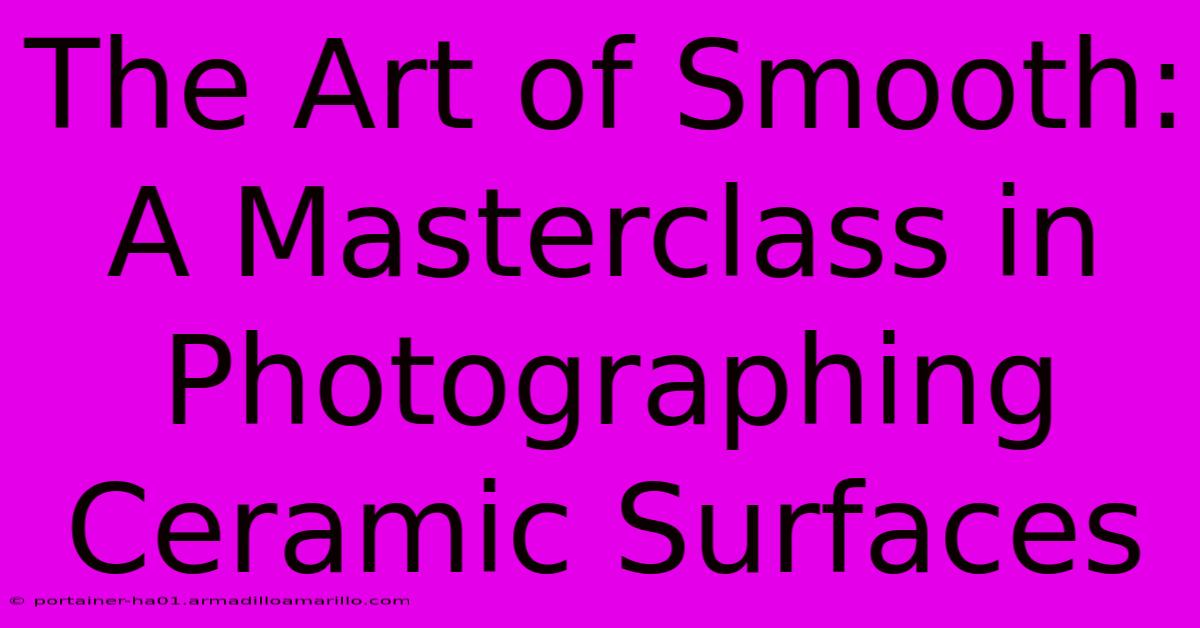The Art Of Smooth: A Masterclass In Photographing Ceramic Surfaces

Table of Contents
The Art of Smooth: A Masterclass in Photographing Ceramic Surfaces
Ceramic surfaces – from the glossy sheen of a modern vase to the rustic charm of a hand-thrown bowl – present unique challenges and rewards for photographers. Capturing their texture, color, and subtle nuances requires a keen eye and a mastery of lighting and composition. This masterclass delves into the techniques that will elevate your ceramic photography from amateur snapshots to stunning, professional-quality images.
Understanding the Challenges of Ceramic Photography
Ceramic objects often reflect light in unpredictable ways, leading to harsh highlights and distracting glare. Their smooth surfaces can appear flat and lifeless if not illuminated correctly. Moreover, the subtle variations in color and texture need to be showcased without appearing overly saturated or artificial.
Mastering the Light: The Foundation of Success
Lighting is paramount in ceramic photography. Harsh, direct sunlight will create unwanted reflections and blow out highlights. Instead, opt for soft, diffused light. This can be achieved in several ways:
- Softboxes: These diffusing tools provide even, shadowless illumination, ideal for highlighting the subtle curves and details of ceramic pieces.
- Diffused Window Light: Natural light filtered through a sheer curtain or diffused by a white reflector provides a soft, natural look.
- Reflectors: Strategically placed reflectors bounce light back onto the subject, filling in shadows and enhancing textures. Experiment with different reflector materials (white, silver, gold) to achieve varying effects.
Composition: Guiding the Viewer's Eye
The arrangement of your ceramic piece within the frame is crucial. Consider these composition techniques:
- Rule of Thirds: Place your subject off-center to create a more visually appealing image.
- Leading Lines: Use lines within the scene to guide the viewer's eye towards the ceramic object.
- Negative Space: Utilize empty space around your subject to emphasize its form and create a sense of calm.
- Background Choices: Choose a background that complements your ceramic piece without distracting from it. Simple, neutral backgrounds often work best. Consider textures that subtly contrast with the smoothness of the ceramic.
Techniques for Enhancing Ceramic Textures and Colors
- Polarizing Filter: A polarizing filter is invaluable for reducing reflections and enhancing color saturation. Experiment with its rotation to find the optimal angle for minimizing glare and maximizing detail.
- Macro Photography: For close-up shots that showcase intricate details, macro photography allows you to capture the fine textures and glazes.
- Post-Processing: Subtle adjustments in post-processing can enhance the colors and contrast of your images. Avoid over-processing, which can result in an unnatural look. Focus on refining the existing qualities of the image, not creating something entirely artificial.
Choosing the Right Camera and Equipment
While you can achieve excellent results with various cameras, a DSLR or mirrorless camera with manual control offers the most flexibility in adjusting settings for optimal lighting and exposure. A tripod is essential for sharp, blur-free images, especially when working with slower shutter speeds in low-light conditions.
Beyond the Basics: Creative Approaches to Ceramic Photography
- Storytelling: Don't just photograph the ceramic object; create a narrative around it. Include props that evoke a specific mood or setting.
- Experiment with Angles: Explore different angles and perspectives to discover unique and captivating viewpoints.
- Series and Sets: Consider creating a series of photographs that showcase a collection of ceramic pieces or different aspects of the same piece.
Mastering the art of photographing ceramic surfaces is an ongoing process. Through consistent practice and experimentation with lighting, composition, and post-processing, you'll develop your unique style and create images that capture the beauty and artistry of these exquisite objects. Don't be afraid to push boundaries and develop your creative vision. The possibilities are endless!

Thank you for visiting our website wich cover about The Art Of Smooth: A Masterclass In Photographing Ceramic Surfaces. We hope the information provided has been useful to you. Feel free to contact us if you have any questions or need further assistance. See you next time and dont miss to bookmark.
Featured Posts
-
Timeless Treasures Design Invitations That Radiate Elegance For An Unforgettable Night
Feb 07, 2025
-
Corporate Card Magic Transform Seasons Greetings Into Marketing Gems
Feb 07, 2025
-
Inside Superside Unveiling The Legitimacy Of The Design Powerhouse
Feb 07, 2025
-
Ai Powered Revolution Mail Hosting In 2024 Where Automation Reigns Supreme
Feb 07, 2025
-
Bridge The Gap Between Old And New The Vga To Hdmi Adapter That Unlocks Endless Possibilities
Feb 07, 2025
